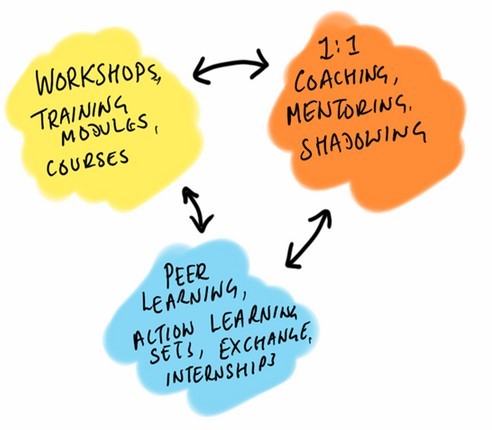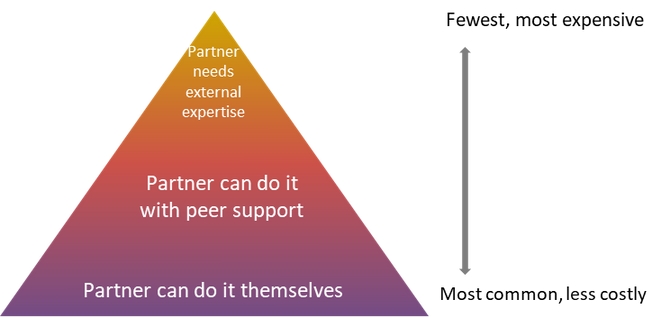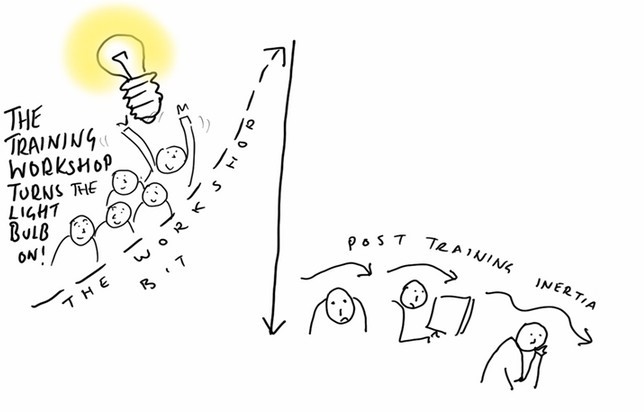Section 06: Choosing methods for PCS
The main message of this section is: putting things into practice, using a mix of methods and encouraging partners to do things themselves are the best ways. Training on its own rarely results in change.
There is no ONE best method! Each has pros and cons. A combination of methods often works well.
6.1: Menu of capacity strengthening (starting with DIY)
How do you learn? Adults often learn best when we need to do something – we observe someone doing it well, or look it up, watch a video on YouTube, ask a mentor, or just have a go and get better at it as we learn from what works and what goes wrong. We rarely sit in a formal class. Capacity strengthening is just the same.
Capacity strengthening starts with what the partner can do themselves, or with peer support. Only a very small part of capacity strengthening needs to come from outside. The realisation that partners can do so much for themselves, is in itself part of capacity strengthening: developing confidence, recognising the power that they have to shape their own change, making their own decisions.
Here’s a list of capacity strengthening activities, many of which a partner can do for themselves or with the help of peer organisations.
An NGO realised that they didn’t even include initiatives which they were doing themselves in their CS plan. If it wasn’t funded by a donor they didn’t have it in their plan, and didn’t monitor or review it! So all the work that they did to develop job descriptions, put safeguarding policies in place and improve their accounting was never recognised.
6.2: Making training more effective
If part of your capacity strengthening includes a training course, then think about how you can make the training as effective as possible. It’s not just a question of what the participant learns. Ultimately, the aim is for something to change! So what can you do ensure that?
It is helpful to reflect on who are the people involved in the training? What does each one need to do before, during, and after the training to make sure the learning gets put into practice?
"I was so excited to be going to Nairobi for the course with people from different countries. The topic was exactly what I was working on. The trainer got us involved and the discussions were so relevant to me.
But when I checked my emails in the lunch break, my manager had sent me a report to revise, so I had to skip lunch and couldn’t sit with other participants. I was very frustrated as they had invested a lot in sending me, and I couldn’t really concentrate.”
Participant on a training
If you are having meetings, trainings or workshops online, get inspiration for better engagement in the ‘Radically Remote’ toolkit. It’s packed with ideas for participation and well- thought through activities to get the most out of online meetings.
6.3: Follow-up support (change takes time!)
For any kind of change to really become part of practice, follow on support is essential. Here’s a few ideas:
Have several people go on a course, so they can work together and support each other to put into practice what they learnt.
Make sure that at the end of a training, there is time for action planning. Involve managers in follow up conversations so they support the changes being made
Organise peer learning sessions between participants on a regular basis for people to share how they are putting things into practice and what challenges/successes they’ve had.
Encourage informal ways of sharing and supporting each other through WhatsApp groups or other social networks.
Provide plenty of affirming feedback for any changes or initiatives that participants put into practice.
Change can be scary. An INGO staff based in East Africa reflects on putting learning from a course into practice:
“These are deep waters we are swimming into. But we are beginning to relax… our fears and anxieties are less. We’ve discovered we can do things differently.”
Last updated


